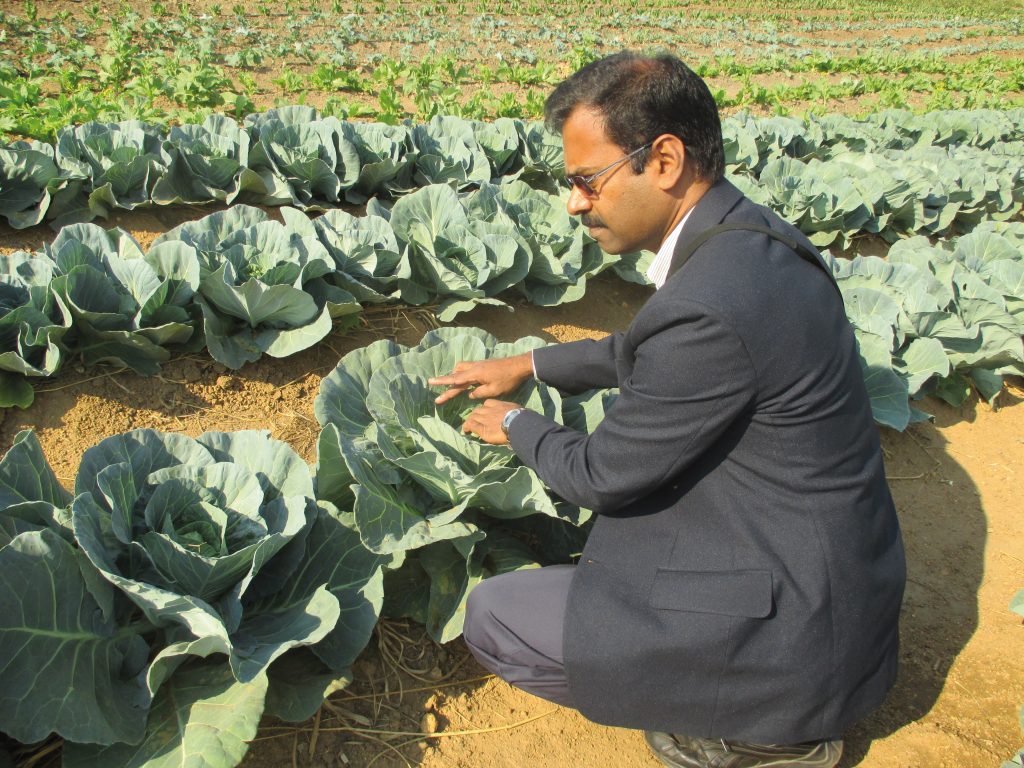Dr Ramu Govindasamy – Ethnic Foods in the Recipe for Farming Success
Farmers in the East Coast of the US are struggling to compete against the larger farms of other regions. Coupled with rising production costs and increasingly difficult growing conditions, producing conventional commodity crops is no longer viable for these farms. Switching to speciality and niche ethnic crops could help these farmers break into a growing market, improve profitability and future viability – and help fulfil the needs of ethnic communities. Dr Ramu Govindasamy from Rutgers University uses a market-first approach to investigate and develop opportunities for farmers to transition to ethnic crop production.
Mutual Benefits of Farming Ethnic Crops
Imagine the taste of home. The cuisine that comes to mind may bring with it a wave of nostalgia. The taste and smells of our favourite foods have the power to bring memories forth from the recesses of our minds. Food can comfort. It can bring joy. It can bring families and friends together and remind us who we are.
It is little wonder then, that food has a central role in so many cultures and communities, and why families that have emigrated to other parts of the world often wish to retain the foods from their homelands. It can help people hold onto a sense of heritage and identity in a scary, new world.
‘Ethnic’ foods, fruits, vegetables, and herbs – those pertaining to a specific group with shared attributes, such as culture or country of origin – often have unique characteristics not shared with any of the conventional crops grown in the US. They are imported to fulfil the demands of ethnic communities or are grown on a limited scale. Many ethnic consumers are willing to pay a premium for these foods, when they can obtain them. As such, opportunities exist for local farmers to fill this niche market by moving away from production of traditional commodity crops and towards production of ethnic crops.
These opportunities are becoming increasingly important for farmers along the East Coast of the US. East Coast farms have been at risk since the 1980s because of highly volatile market prices. Additionally, East Coast farmers operate on relatively small land areas in comparison to the larger crop farmers from the mid-West, resulting in a higher production cost per unit of crop output. This puts them at a competitive disadvantage and threatens the long-term viability of their operation. For traditional ‘commodity crop’ farms (growing staples such as corn and soybean) large acreage and lower relative production costs are critical to be economically feasible.

Many East Coast farmers have already begun transitioning to the production of speciality and niche crops, including ethnic crops, to increase profitability. By tapping into a different market, these farmers mitigate the competitive disadvantage they have when producing similar crops to their larger competitors. The rapid expansion of ethnic populations along the East Coast – and their purchasing power – presents local farmers with significant opportunities to forge a niche for themselves within a market that is likely to continue expanding in the future. Additionally, being within proximity of densely populated areas in the region may help to reduce the costs and difficulties associated with distribution and ensuring produce is still fresh when reaching the shelves.
But trying to capitalise on any market without first understanding that market is to tempt disaster. East Coast farmers need strategies underpinned by reliable evidence before beginning the transition to ethnic crops. Understanding the market and the needs of potential consumers is vital to ensure long-term economic viability. Equally important is identifying ethnic crops suited to the growing conditions in the US, using reliable scientific evidence.
Dr Ramu Govindasamy of Rutgers University and his collaborators have been developing strategies for East Coast farmers to transition to ethnic crop production based on scientific and market evidence. He emphasises a market-first approach that helps to mitigate grower risk and guarantee success by matching the needs of consumers more precisely with food production. By developing coordinated production and cooperative marketing strategies between farms along the East Coast, Dr Govindasamy aims to prevent rapid over-production of specific crops and the associated price depression, and ensure year-round availability of these foods for ethnic communities throughout the region.

Understanding Ethnic Consumers
Ethnic populations contribute a great proportion of the total US population growth. Between 2000 and 2010, the US population increased by 9.5%. In contrast, the Hispanic population increased by 34% and the Asian population increased by 33% during the same period. Over one million foreign-born people become legal permanent residents of the US each year. The East Coast region, in particular, is characterised by the high proportion of the growing ethnic population.
By extrapolating results obtained through consumer surveys to population sizes, Dr Govindasamy estimated the potential ethnic produce markets for different ethnic subgroups along the East Coast. He estimated the annual market for Chinese produce at US $245 million to $296 million, while appealing to Asian Indian communities could capture a market worth US $190 million to $230 million per annum. Similar potential exists within the Hispanic community market, with the East Coast Mexican market annual worth estimated at US $281 million to $362 million, and the Puerto Rican markets potentially netting US $531 million to $655 million per year.
Although Dr Govindasamy’s consumer profile investigations revealed some similarities between ethnicities and ethnic subgroups useful for creating a general profile for the consumer group as a whole, exploring the relevant characteristics, shopping patterns, preferences, and opinions of ethnic subgroups is critical for effectively targeting specific ethnic markets. ‘The type of food cooked, patterns of purchasing produce, and amount spent on food are very centric to and dependent on cultural trends,’ says Dr Govindasamy.
For example, the Hispanic community is diverse – in addition to Mexicans and Puerto Ricans, Hispanic communities also originate from Cuba, Central and South America, and other Spanish-speaking cultures. Dr Govindasamy found that some of the most promising ethnic crops to cultivate and market to appeal to the East Coast Mexican community include tomatillo, jalapeno chili peppers, calabacita squash, and pablano or ancho chili peppers. In contrast, promising crops favoured by Puerto Rican communities include culantro, pepinillo, batata sweet potatoes, and aji dulce sweet peppers.
Understanding where and how different ethnic communities prefer to shop for their produce can also inform effective distribution and marketing strategies. ‘Many ethnic communities have their own channels of produce distribution outside the traditional retail supermarket industry and few studies have studied this informal and growing industry and its consumer base,’ explains Dr Govindasamy. In recent research investigating the ethnic food preferences of Chinese, Asian Indian, Mexican, and Puerto Rican consumers, he found that 88% of the individuals surveyed bought their ethnic greens and herbs from ethnic grocery stores. By expanding and developing distribution networks based on these results, farming businesses could capture more of the potential consumers.
Putting these strategies in place could also help East Coast farmers future-proof their enterprises by priming them for emerging markets. ‘As ethnic demographic profiles change, fresh produce marketers and commercial growers aware of such trends may be able to alter or add to their selection of crops to effectively respond to new trends and changes in demand,’ Dr Govindasamy explains.

Refining Production Strategies
In addition to informing strategies for marketing and distribution, Dr Govindasamy also helps farmers identify suitable ethnic crops for production in the East Coast through careful selection and subsequent field trials. In his research on Asian Indian and Chinese consumers, Dr Govindasamy used surveys to identify the vegetables, leafy greens, and herbs most sought by these communities. Over 100 potential Asian ethnic crops were identified, narrowed down by a panel of experts based on production barriers, such as climate, growth cycle, seed availability and regulation, and market competition. In another study, which also included Mexican and Puerto Rican consumers, Dr Govindasamy and his panel of experts narrowed down the list of potential ethnic crops to 10 per ethnicity before using surveys to rank them in terms of popularity.
Field production trials were used to refine growing strategies to maximise productivity. Assessing plant vigour, yield, and growth rate over multiple years and across different regions of the East Coast helps farmers select the most appropriate ethnic crops to produce for their individual farms. As these plants are not native to the US, careful consideration was also given to the potential for these species to become invasive. Appropriate management strategies were devised from this evidence, such as timely harvesting to prevent plants setting seed. The findings from these trials help farmers make informed decisions about which ethnic crops, and which cultivars, are economically viable for commercial production.
In addition to production trials, Dr Govindasamy and his team conducted nutritional assessments on the ethnic crops selected. This revealed that many of these food plants are nutrient dense and a rich source of vitamins and minerals. Scientific analyses such as these can drive market interest, and may even help ethnic foods reach the mainstream markets. ‘In addition to taste and visual appearance, today’s healthy choice for food calls for increased nutritional value from eating a diversity of horticultural crops,’ explains Dr Govindasamy, ‘Mainstream consumers may find expanded or even better choices from ethnic vegetable, leafy green, and herb cultivars.’
Dr Govindasamy and his team’s market-first, science driven approach has proven successful for agricultural business enterprises around the world. By providing East Coast farmers with reliable, thorough strategies for transitioning to ethnic crop production, their future economic viability is vastly improved. By investigating ethnic consumers’ preferences and needs, these communities get improved access to their favourite foods from their homelands. Using Dr Govindasamy’s approach, everyone’s a winner.
Reference
https://doi.org/10.33548/SCIENTIA595
Meet the researcher

Dr Ramu Govindasamy
Department of Agricultural, Food and Resource Economics
Rutgers University
New Brunswick, NJ
USA
Dr Ramu Govindasamy is Professor of Agribusiness Marketing at Rutgers University. Here, he also serves as Chair of the Department of Agricultural, Food and Resource Economics. Dr Govindasamy’s nationally and internationally recognised research has led to over 100 publications in peer-reviewed journals, 150 professional and invited presentations, and 45 external research grants. In the USA, his research focuses on direct marketing, organic produce marketing, ethnic produce marketing, and natural products including herbal medicine. Within a few years of his appointment at Rutgers University, Dr Govindasamy was awarded the Research Excellence Award. He was also awarded the Presidential Emerging Leadership Award by the Food Distribution Society in 2004, and has served as the president of the association in 2018.
CONTACT
E: govind@sebs.rutgers.edu
W: https://njaes.rutgers.edu/personnel/individual/112
KEY COLLABORATORS
Dr Albert Ayeni, Department of Plant Biology and Pathology, Rutgers University
Dr Kathleen M. Kelley, Department of Horticulture, The Pennsylvania State University
Mr Stephen J. Komar, Mr Peter Nitzsche, Dr William J. Sciarappa, Mr Richard W. Van Vranken, Agricultural & Resource Management Agents, Rutgers University
Dr Frank Mangan, Department of Plant, Soil and Insect Sciences, University of Massachusetts Amherst
Dr Gene McAvoy, Institute of Food and Agricultural Sciences Hendry County Extension, University of Florida
Dr Brian Schilling, Rutgers Cooperative Extension, Rutgers University
Dr James E. Simon, Center for Agricultural Food Ecosystems, and Department of Plant Biology, Rutgers University
Dr Shouan Zhang, Department of Plant Pathology, University of Florida
FUNDING
Cooperative State Research, Education and Extension Service – United States Department of Agriculture (USDA)
National Institute of Food and Agriculture (NIFA) – USDA
FURTHER READING
R Govindasamy, KM Kelley, JE Simon, Demographic Analysis of Ethnic Greens and Herbs Consumers, Journal of the Journal of the American Society of Farm Managers and Rural Appraisers, 2017, 43.
WJ Sciarappa, JE Simon, R Govindasamy, KM Kelley, F Mangan, S Zhang, S Arumugam, P Nitzsche, RW Van Vranken, SJ Komar, A Ayeni, Asian crops overview: Consumer preference and cultivar growth on the east coast of the United States, HortScience, 2016, 51, 1344.
R Govindasamy, S Arumugam, X You, I Vellangany, Willingness to Buy Organically Grown Ethnic Greens and Herbs: A Consumers Survey in the East-Coast Region of United States, Agricultural Economics Research Review, 2015, 28, 213.
A Ariyawardana, R Govindasamy, V Puduri, Preference for ethnic specialty produce by the Hispanics in the east coast of the USA, British Food Journal, 2012, 114, 944.
R Govindasamy, VS Puduri, JE Simon, Willingness to Buy New Ethnic Produce Items: A Study of Latino Consumers from Mexico and Puerto Rico in the Eastern United States, HortTechnology, 2011, 21, 202.

Want to republish our articles?
We encourage all formats of sharing and republishing of our articles. Whether you want to host on your website, publication or blog, we welcome this. Find out more
Creative Commons Licence
(CC BY 4.0)
This work is licensed under a Creative Commons Attribution 4.0 International License. 
What does this mean?
Share: You can copy and redistribute the material in any medium or format
Adapt: You can change, and build upon the material for any purpose, even commercially.
Credit: You must give appropriate credit, provide a link to the license, and indicate if changes were made.
More articles you may like
How Food Environments Shape Our Eating Habits
How we eat dramatically impacts our health, yet millions of Americans live in ‘food deserts’ – areas with limited access to fresh, nutritious food. Recent research reveals that solving this crisis requires looking beyond just physical access to food to understand how our entire community environment shapes our dietary choices. Through a series of pioneering studies, Dr Terrence Thomas and colleagues at North Carolina A&T State University have been investigating how different aspects of our food environment influence what we put on our plates. Their findings suggest that creating lasting change requires reimagining how communities engage with food at every level.
Probing Electron Dynamics in the Ultrafast Regime
In the atoms that make up the matter around us, negatively charged particles called electrons have properties such as spin and orbital angular momentum. Researchers at Martin Luther University Halle-Wittenberg have developed a theoretical framework which allows them to simulate the dynamics of the spin and orbital angular momentum of electrons in materials when probed with an ultrafast laser pulse. Using this framework, they are able to simulate different materials and improve our understanding of dynamics on an atomic scale.
Seeing Beneath the Surface: Exploring Deltaic Reservoirs with Augmented Reality
In the Aínsa Basin of the Spanish Pyrenees, the Mondot-1 well was drilled, cored, and fully logged to capture a detailed record of a long-buried ancient river delta system. Dr. John D. Marshall, Dr. Jürgen Grötsch, and Dr. Michael C. Pöppelreiter with co-workers at Shell International used this core to trace how sediments once flowed across the landscape, and were deposited under shifting tectonic conditions. The team employed augmented reality and interactive virtual displays; these innovative tools offer new ways to explore subsurface depositional systems, and are particularly useful in locations where physical access to the core is difficult, or no longer possible.
Dr Jim Wu | Ziresovir Offers New Hope for Treating Respiratory Syncytial Virus Infections
Respiratory syncytial virus (RSV) causes respiratory tract infections in children and adults. While for many patients the outcomes of infection are mild, for others, infection can prove fatal, and there is a lack of effective treatments. Dr Jim Wu from the Shanghai Ark Biopharmaceutical Company in China carries out his vital research to develop new, safe, and effective treatments to tackle this killer.




